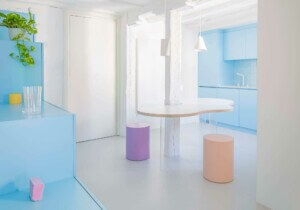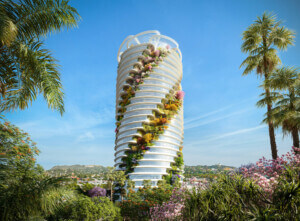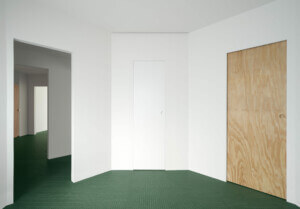The Architect’s Newspaper is in Madrid for The Future is Now Forum, the inaugural event hosted by the Norman Foster Foundation. The Forum featured a remarkable list of figures from the design world and beyond, from Pritzker Prize–winning architect Alejandro Aravena to former New York City Mayor Michael Bloomberg and historian Niall Ferguson. Foster and numerous panelists were optimistic that design and technology could provide solutions for an ecologically and urbanistically challenged planet, though the path forward isn’t without dangers and challenges.
The forum was, in a way, the Madrid-based Foundation’s debut. The organization aims to foster innovation and research on the built environment while also implementing real-world projects, such as the Droneport featured at the 2016 Venice Architecture Biennale and slated for construction in Rwanda. The Foundation is inherently interdisciplinary in scope, with its wide-ranging focus extending from architecture to infrastructure, engineering, technology, cities, the arts, and more. “I describe it as questioning traditional hierarchies and adopting a roundtable approach to creativity,” said Foster in a description of the organization.
The Foundation (which is entirely separate from Foster + Partners) grew out of a series of international traveling scholarships for architects that Foster initiated in 2007. A physical space for the Foundation would not only receive the scholars, but promote its “holistic approach to design” to a wider audience through a range of programming and exhibitions. Those activities will be grounded with the Foundation’s archive of Foster’s work, which includes prototypes, drawings, transcripts, films, photographs, models, and more. Since 2017, more than 74,000 items have been cataloged and more than half those items are already digitized. Eventually, all of them will be available on the publicly accessible online archive.
While the Foundation introduced its new headquarters two days ago (AN will follow up on its design when images become available), today was its inaugural Forum, which was split into three sections: Cities, Technology and Design, and Infrastructure. Foster kicked off the forum by describing the challenges the world faces, specifically rapid urbanization, a transportation revolution (such as driverless cars and pedestrianizing cities), and climate change. With a heavy dose of Buckminster Fuller, he emphasized the need for interdisciplinary intervention and holistic design, something the Foundation will do.
Lord Foster: Facing ecological crises, the design of buildings and infrastructure is “far too important to be left to one profession.” pic.twitter.com/jNoz0Xqc0p
— Architects Newspaper (@archpaper) June 1, 2017
The first panel (featuring former NYC Mayor Michael Bloomberg, Richard Burdett, Professor of Urban Studies at London School of Economics, architect Maya Lin, and Foster himself) was fairly straightforward, with an emphasis on the benefits of urban density and the inherently democratic nature of cities. The overriding theme was a need for strong political leadership to present grand and compelling visions to tackle urban woes: “Cities in the West have forgotten the power of planning,” Foster lamented.
Michael Bloomberg: Climate change, nuclear war, and the destruction of jobs with technology are the three “cataclysmic” challenges we face. pic.twitter.com/YGGYvY3xUE
— Architects Newspaper (@archpaper) June 1, 2017
Elon Musk’s Hyperloop and Bogotá’s highly successful bus rapid transit (BRT) system were also highlighted as examples of successful, radical thinking as well. But it was a comment from former Mayor Bloomberg about technology eliminating jobs that would set the stage for sharp disagreements in the next panel.
The second panel focused on technology and design. It started with a set of striking projects from Professor Matthias Kohler of the Swiss Federal Institute of Technology, which included flying drones constructing a brick tower and robots fabricating a new kind of formwork that allows for curving concrete shapes. Nicholas Negroponte, co-founder of MIT Media Lab, was especially bullish on technology’s potential to shape design: “The end of constructing things of components” such as bricks or concrete is coming to an end. Architecture will be “like planting a seed and watching a building grow… additive construction is over.” Niall Ferguson, senior fellow at the Hoover Institution, countered that a massive backlash was coming for all this progress: When middle America and Europe figure out that technology is taking their jobs, he said, there will be resistance, even if it’s futile.
Niall Ferguson: Silicon Valley is “terrifyingly historically ignorant,” massive backlash is coming as tech eliminates jobs/middle class. pic.twitter.com/55iZDUgHSl
— Architects Newspaper (@archpaper) June 1, 2017
Citing Uber as an especially egregious example, he argued that Silicon Valley sees its inventions and inherently “awesome” and unstoppable, thereby failing to anticipate the reaction of those on the losing side of innovation. Furthermore, Ferguson described how many scientific inventions—from splitting the atom to drones—were frequently turned into weapons of war. His critique was hotly debated by Negroponte, though it succeeded in introducing doubt to the techno-utopian aspects of the Forum’s Buckminster Fuller-esque aspirations.
A. Aravena: “Cities could become social ticking time bombs” or “shortcuts to equality.” New kinds of multipurpose infrastructure are key. pic.twitter.com/h5j8bDtw2m
— Architects Newspaper (@archpaper) June 1, 2017
Next, Chilean architect Alejandro Aravena delivered the keynote prelude to the final panel on infrastructure. He delivered a more grounded argument about the need for infrastructure to serve multiple roles in the cities. In the face of massive urban inequality, he said, we can’t touch income directly but we can strategically design public spaces, transportation, and other urban infrastructure to ameliorate the problem. Examples included using hard infrastructure (e.g. waste treatment) to create new public spaces or platforms for housing, providing opportunities for individuals to be self-sufficient and off the grid, and prioritizing space-efficient transit (such as walking, biking, and buses over cars) in the precious public space of streets.
His thoughts were echoed throughout the final panel that followed. Henk Ovink, Special Envoy for International Water Affairs for the Kingdom of the Netherlands and seminal figure in Rebuild By Design, emphasized that infrastructure is a political and cultural challenge as well an engineering one. “We had a water democracy in the 1100s,” he said of the Netherlands, which meant the public was always deeply included in the design process. Without a similar process, communities won’t understand, own, or accept big infrastructure projects.
Also on the panel was Jonathan Ledgard, director of Rossums Group and leader of the Norman Foster Foundation’s Droneport project, who sought to counter Ferguson’s earlier critique. He cited the Droneport, a hub for commerce and community where drones bring and send away small, high-value goods (such as medicine or mechanical parts) as one example of how low and high technology can mix to benefit the common good.
Foster concluded the forum on a historical note. While cars have become the enemies of cities, they were once their saviors, as they eliminated the mountains of horse manure that horse-driven carriages and trucks created. Yesterday’s friend can become today’s enemy. Still, he said, “the exchanges today give me great hope for the future.”










